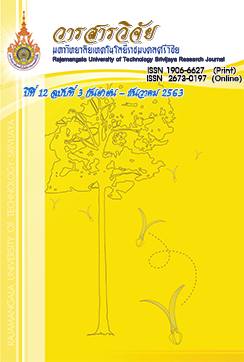Effect of Thorn Apple Oil Massage on Neck and Shoulder Pain from Office Syndrome in Students of Kanchanabhishek Institute of Medical and Public Health Technology
Keywords:
thorn apple oil, massage, office syndromeAbstract
Office Syndrome is a common symptom in working people and students in the inappropriate workplace environment such as sitting during working all the time without body movement. These things result in inflammation of the muscles and pain in various organs such as neck and shoulders. This quasi-experimental research aimed to examine the effect of Thorn apple oil massage on neck and shoulder pain from office syndrome. The samples were 30 students of Kanchanabhishek Institute of Medical and Public Health Technology, conducted by the purposive sampling method. The research instruments used for data collection were numeric rating score, algometer, inclinometer, hand book of massage and data record. The statistical procedures employed included frequency, percentage, means, standard deviations and paired sample t-test. The results showed that before the massage, volunteers had the pain level ( = 5.33), degree of neck movement in the bent direction ( = 52.367), perk ( = 66.73), tilt to the left ( = 42.10) and right ( = 42.93), and level of sore feeling ( = 32.83). After oil massage, volunteers had the pain level ( = 3.10), degree of neck movement in the bending direction ( = 63.23), perk ( = 76.37), tilt to the left ( = 53.87) and right ( = 53.13), and pressure level ( = 43.30). The findings revealed that Thorn apple oil massage significantly reduced pain level and increased the capability of neck movement in the bending direction, left and right tilt, and pressure level at the .001 level. All three kinds of oil can be used interchangeably. As a result, Thorn apple oil massage is the appropriate option to lower the muscle pain from office syndrome.
References
สงขลานครินทร์ วิทยาเขตหาดใหญ่. วารสารสาธารณสุขศาสตร์ 44(2): 162-173.
เกศ สัตยพงศ์. 2553. ความชุกและปัจจัยที่เกี่ยวข้องของอาการผิดปกติของระบบกล้ามเนื้อและกระดูกโครงร่างในอาชีพหมอนวดแผนไทย. วิทยานิพนธ์วิทยาศาสตรมหาบัณฑิต การวิจัยและการจัดการด้านสุขภาพ, จุฬาลงกรณ์มหาวิทยาลัย.
คณะเภสัช มหาวิทยาลัยมหิดล. 2558. บทความเผยแพร่ความรู้สู่ประชาชน ลำโพง : ไม้ประดับมีพิษ. สำนักงานข้อมูลสมุนไพร คณะเภสัชศาสตร์ มหาวิทยาลัยมหิดล. แหล่งที่มา: https://goo.gl/wpkdMy, 11 กันยายน 2560.
คัญฑมารา สิทธิไกรพงษ์, ปารัณกุล ตั้งสุขฤทัย, ปรีชา หนูทิม, วไลรัตน์ ศิริวงศ์ และ ภาวิณี อ่อนนุช. 2557. การศึกษาเปรียบเทียบประสิทธิผลการนวดไทยกับการใช้ยาไดโคลฟีแนค (Diclofenac) ในการลดอาการปวดบ่า. วารสารวิชาการสาธารณสุข 23(5): 842-849.
จุลจิรา ธีรชิตกุล, ขนิษฐา นาคะ และ ปิยะภรณ์ บุญพัฒน์. 2555. การจัดการอาการปวดเมื่อยกล้ามเนื้อของผู้สูงอายุที่มีอาชีพกรีดยางพารา. วารสารสภาการพยาบาล 27(2): 134-147.
ชาคริต สัตยารมณ์, ลดาวัลย์ อุ่นประเสริฐ, พงศ์ นิชโรจน์ และ นพวรรณ เปียซื่อ. 2557. ผลของการนวดด้วยน้ำมันหอมระเหยและประคบสมุนไพรร่วมกับการใช้ยา ต่ออาการปวดหลังส่วนล่างและปฏิกิริยาสะท้อนความตึงตัวของกล้ามเนื้อในผู้ที่มีอาการปวดหลังส่วนล่าง. วารสารวิทยาลัยพยาบาลพระปกเกล้า จันทบุรี 25(2): 1-13.
ชำนาญ ผึ่งผาย. 2550. ผลการนวดแผนไทยประยุกต์ต่อการผ่อนคลาย. วิทยานิพนธ์วิทยาศาสตร์มหาบัณฑิต สาขาวิทยาศาสตร์การกีฬา, มหาวิทยาลัยศรีนครินทรวิโรฒ.
รุ้งทิพย์ พันธุเมธากุล, รวิพร พิทักษ์, วิชัย อึงพินิจพงศ์, พีราภรณ์ โลหะมงคล, วรวุฒิ อุสุภราช, ศุภาพิชญ์ บุญเสนา และ ธวัชชัย สุวรรณโท. 2559. ผลทันทีของการนวดด้วยเทคนิคพิเศษบริเวณปลายสะบักจนถึงชายโครงในผู้ป่วยที่มีอาการปวดคอ. วารสารเทคนิคการแพทย์และกายภาพบำบัด 28(2): 135-143.
โรงพยาบาลอภัยภูเบศ. 2558. “ลำโพง” สมุนไพรสวยพิฆาต ฆ่าแบคทีเรีย-รักษาแผลหนอง. แหล่งที่มา: http://www.thinsiam.com/%E0
%B8%84%E0%B8%A5%E0%B8%B1%E0%B8%87%E0%B9%80%E0%B8%81%E0%B9%87%E0%B8%9A/22081, 1 มิถุนายน 2562.
วิทย์ เที่ยงบูรณธรรม. 2554. พจนานุกรมสมุนไพรไทย. พิมพ์ครั้งที่ 5. สํานักพิมพ์รวมสาส์น, กรุงเทพฯ.
วิทยา บุญวรพัฒน์. 2554. สารานุกรมสมุนไพรไทย-จีน ที่ใช้บ่อยในประเทศไทย. สมาคมศาสตร์การแพทย์แผนจีนในประเทศไทย, กรุงเทพฯ.
สุธรรม อารีกุล. 2552. องค์ความรู้เรื่องพืชป่าที่ใช้ประโยชน์ทางภาคเหนือของไทย. มูลนิธิโครงการหลวง, เชียงใหม่.
สุนิสา ชายเกลี้ยง และ รัชติญา นิธิธรรมธาดา. 2559. ปัจจัยที่มีความสัมพันธ์กับการปวดคอ ไหล่ หลังของบุคลากรในโรงพยาบาลของรัฐ จังหวัดขอนแก่น. วารสารสาธารณสุขศาสตร์ 46(1): 42-56.
โสภา ลี้ศิริวัฒนกุล, คณิสร แก้วแดง และ วิภารัตน์ ภิบาลวงษ์. 2557. การเปรียบเทียบประสิทธิผลของการนวดเพื่อผ่อนคลาย แบบนวดโดยใช้น้ำมันไพลกับนวดแบบดั้งเดิมในผู้ที่มีปัญหาปวดไหล่และคอ. วารสารวิทยาลัยพระปกเกล้า จันทบุรี 5(2): 41-51.
Abena, A.A., Miguel, L.M., Mouanga, A., Hondi Assah, T. and Diatewa, M. 2003. Evaluation of analgesic effect of D. fastuosa L. leaves and seed extracts. Fitoterapia 74(5): 486-488.
Cohen, J. 1992. Quantitative methods in psychology: A power primer. Psychological Bulletin 112(1): 155-159.
De Padua, L.S., Bunyapraphatsara, N. and Lemmens R.H.M.J. 1999. Plant Resources of South-East Asia No. 12(1). Medicinal and Poisonous Plants 1. Backhuys Publishers, Leiden, Netherlands.
Webb, A. 2017. Management of nausea and vomiting in patients with advanced cancer at the end of life. Nursing Standard 32(10): 53-63.
Downloads
Published
How to Cite
Issue
Section
License
The content and information in the article published in Journal of Rajamangala University of Technology Srivijaya It is the opinion and responsibility of the author of the article. The editorial journals do not need to agree. Or share any responsibility.







